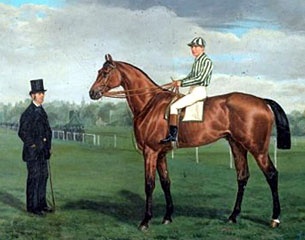
(by Chris Hector of The Horse Magazine) Everywhere you travel in the world of performance horse breeding, breeders discuss the difficulty of finding new Thoroughbred stallions and the need for Thoroughbreds to maintain the breeding programs
– yet, paradoxically, it seems while we may still need Thoroughbred blood, perhaps we don’t need Thoroughbreds any more…The conventional wisdom is set out by Holstein breeding director, Thomas Nissen, in an interview with Tom Reed of Ireland’s Morningside Stud in Horse International. Nissen is looking to maintain the Thoroughbred in the Holstein mix:
“For us it is important that the type is not too heavy. Cassini and Contender are more the heavy type, and if you look at the catalogue (of the 2008 Stallion Licensing) we have 16 stallions out of half-blood mares with the Thoroughbred influence. We have not so many sons of Thoroughbreds, only two this year. One we approved – Esquire by Esteban xx. I hope next year it will grow a little bit so we can approve two or three half-blood stallions.”
“It is difficult for the breeders to accept a half-blood stallion because they are always looking to the older progeny jumping. But I think it is necessary. It is important for us and (also) for me to support the Thoroughbred influence because we need it. Our breed can only develop in a good and right way for the sport when the breeders take always a little Thoroughbred influence in our population. It is necessary. The breeders are critical. They know that it is important but they say, OK, but my neighbour can do it!"
This attitude of not-in-my-backyard, may be one of the reasons Thoroughbred and half-bred stallions are not producing performers – they just don’t get the best mares. As Nissen told Reed:
“I think it is necessary that the breeders use Thoroughbreds but use them with very good thinking about which mare is right for the Thoroughbred. You need for a Thoroughbred stallion, your best mother line, with a good background, a good stamm behind it, and good jumping ability. This is necessary because in other ways the risk is too big that the result goes this way and that way. The breeder should use a Thoroughbred stallion on a mare with a good mother line and hope that they get a filly and then bring that filly to their breeding stock. That is the way. And if they have a half-bred mare they could use a stallion like Contender or a son and then we have the influence of the Thoroughbred from the mother and from the father we have the top genetics of a sport horse. I think that is our way forward.”
As usual the French breeding authority Arnaud Evain, has his own individual take on the situation, and he is not so worried:
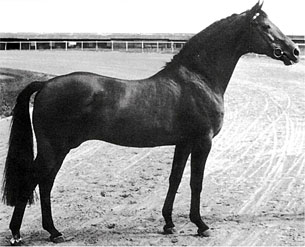 “One of the major reasons that French breeding is appreciated in the world today is because of Thoroughbreds. We used the proper Thoroughbreds, the bad ones we used also, but no one remembers them, they disappeared from the dam lines. Now if you go into the pedigrees of the French book, and you find stabilized horses with between 15% and 20% Thoroughbred blood – the situation is much the same in Holland – and when you mix those horses together you keep 15-30% Thoroughbred.”
“One of the major reasons that French breeding is appreciated in the world today is because of Thoroughbreds. We used the proper Thoroughbreds, the bad ones we used also, but no one remembers them, they disappeared from the dam lines. Now if you go into the pedigrees of the French book, and you find stabilized horses with between 15% and 20% Thoroughbred blood – the situation is much the same in Holland – and when you mix those horses together you keep 15-30% Thoroughbred.”
“The use of a new Thoroughbred was a must, fifteen to twenty years ago, when you had to select the good bloodlines and keep adding ‘blood’ into the heavy horses. The heavy Dutch horse carrying the milk in the country, the heavy Holsteiner, the heavy Hanoverian, if you see the pictures of the stallions from the 50s in all the studbooks, they were big horses.”
“It was similar in France. The dam of Almé, she was working in the field. She was by a Thoroughbred, but her grand-dam was a very heavy horse, and she was doing a job in the fields, and having a foal at the same time! But now we have these good Thoroughbred bloodlines we have kept in the French breed – Furioso, Rantzau, Fra Diavolo, I can name ten that provide 90% of the quality. Go to Germany and you will find Ladykiller, Sacramento Song, another group of ten. But now we have them - if you take a drink with 20% alcohol and mix it with another drink with 20% alcohol, we still have a 20% alcohol. The same with our horses, we can breed the horse with 20% Thoroughbred blood to another with 20% and keep the percentage we need.” “You have horses today in competition, with no Thoroughbred in the first three generations, but they have a lot of blood. Thoroughbred does not have the exclusivity of blood any more. Take Quidam de Revel, if you look at his pedigree it is quite cold blooded but he has one Thoroughbred in the third generation which is pushing blood all through the pedigree.”
“What you expect from a Thoroughbred is a quick thinker. As a rider said to me once – a short distance between the legs and the brain. The horse can have a long neck or a short neck, but it has to be a short distance between your legs and hands and his brain – that’s what we call ‘blood’. In the 70’s only the Thoroughbreds had that quality – now we have a lot of Warmbloods with the same quality. A good Thoroughbred is wonderful but who is going to pay to detect him?” In a ground breaking piece of research, Florian Sitzenstock from the University of Goettingen, seems to bear out Arnaud’s thesis. He looks at the influence of the Thoroughbred in the Hanoverian studbook since 1985 and comes to the paradoxical conclusion that while the percentage of horses by full-blood or half-blood sires has diminished, the percentage of Thoroughbred blood in the Hanoverian population has increased!
The study examined the pedigrees of a total of 217,475 Hanoverian foals from 1980 until 2006 and found that the average proportion of Thoroughbred blood in the foals was 23%, with an increase from 20% in 1980 to 25% in 2006. During that period, the percentage of horses with no Thoroughbred blood, dropped from 40% to 4%!
With the shortage of Thoroughbred mares in Germany, it is no surprise that the infusion came mainly through Thoroughbred stallions. However it is noticeable the actual share of Thoroughbred, and half-bred coverings has declined. This decline would have been much greater without the influence of the two great Hanoverian Thoroughbred stallions of modern times: Prince Thatch xx and Lauries Crusador xx.
In 1990, when the two stallions joined the band at Celle, they were responsible for 29% of half-bred foals produced that year. In 2006, 61% of all the half-bred Hanoverian foals were by ‘Lauries’.
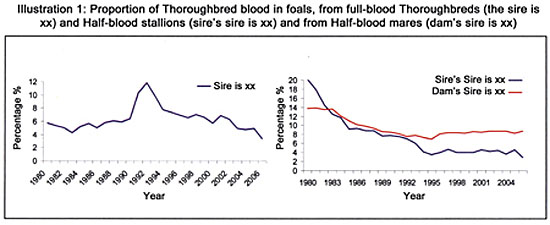
Illustration 1, shows the share of foals whose sire, sire's sire, or dam's sire was a Thoroughbred. The share of half-bred foals decreases consistently since 1993. Half bred stallions produced 20% of the foals of the 1980 crop, but just 3% of the foals born in 2006, while the number of half-bred mares decreased from 14% to 9%. Since the actual percentage of Thoroughbred blood increased in the period, it is to be found in the third and four generation – reflecting Arnaud Evain’s observation that once the mix is ‘right’ by breeding part Thoroughbred to part Thoroughbred, there is little need for the full blood in the program. The FN breeding values show that a proportion of Thoroughbred blood strongly relates to performance ability for both dressage and jumping, although for jumpers the infusion needs to be further back in the pedigree.
An increased proportion of Thoroughbred blood positively influences the dressage breed value, while it has a negative impact on the jumper index. On the other hand, horses with 25% Thoroughbred blood showed a better breed value for jumping than horses with no Thoroughbred blood at all.
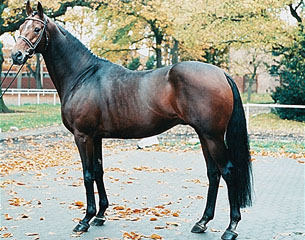 The Thoroughbred has been very important in improving conformation in Hanover. The Hanoverian breed values for conformation are positively influenced by Thoroughbred blood up to a proportion of 62.5%. The Hanoverian values show a positive Thoroughbred influence for frame, saddle position and type while the front legs in particular benefitted. Crossbreeding with a Thoroughbred in the first two generations positively affected the breed value for dressage and both exterior breed values. Half-breds surpassed Thoroughbreds in their positive influence. However the breed value for jumping was negatively influenced by cross-breeding.
The Thoroughbred has been very important in improving conformation in Hanover. The Hanoverian breed values for conformation are positively influenced by Thoroughbred blood up to a proportion of 62.5%. The Hanoverian values show a positive Thoroughbred influence for frame, saddle position and type while the front legs in particular benefitted. Crossbreeding with a Thoroughbred in the first two generations positively affected the breed value for dressage and both exterior breed values. Half-breds surpassed Thoroughbreds in their positive influence. However the breed value for jumping was negatively influenced by cross-breeding.
The conclusion reached by the researcher, Florian Sitzenstock puzzles me, since although his wonderful and copious research seems to show what Arnaud Evain intuitively knew, he ends up echoing the conventional wisdom: “it can only be recommended to increase the use of Thoroughbred and half-bred stallions as well as half-bred mares in the breeding program. An increased use, especially of new Thoroughbred sires as well as young stallions with a lot of blood, will allow for an opportunity for those sires to prove their inheritable qualities. The high-in-demand blood connection in pedigrees can only be guaranteed, if English Thoroughbreds are continuously used also today.”
The results of Florian Sitzenstock’s researches were published in the July 2009 edition of Der Hannoveraner (once again, thanks to the Hanoverian Verband for providing the translation) along with a comment from Dr. Ludwig Christmann:
“Florian Sitzenstock established in his dissertation that today's Hanoverian population has a Thoroughbred share of 25 percent. He researched the past thirty years, a time frame during which a lot happened in the breed. Overall the types have improved, meaning: more hot-blooded horses with longer legs, equipped with the desired, so-called riding horse points.” “The need for refinement appears not as high as 30 years ago. That does, however, not mean that we want or can abandon Thoroughbreds as a refining breed. It means that we can approach the use of Thoroughbreds with a certain calmness, but also with a necessary consequence. Calmness means that only those Thoroughbreds are to be used, which are equipped with moving ability, rideability, and/or jumping talent; consequence means that we continue to carefully search for such Thoroughbreds.”
“Differences became clear between the use of Thoroughbred blood in the breeding of dressage horses and jumper horses. The fact that an increasing share of Thoroughbred blood positively influenced the breed value for dressage is certainly closely connected to the unique situation in Hannover. During the research period, such exceptional Thoroughbreds like Lauries Crusador xx, Prince Thatch xx, and Sunlight xx - all three more dressage oriented - were in breeding service in Hannover. The influence of Lauries Crusador xx continues to grow.”
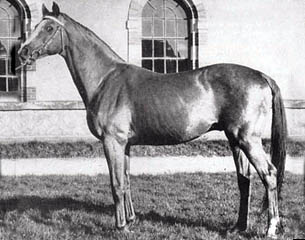 “Today horses like Shutterfly and Souvenir, both of which have half-bred dams, prove the importance of Thoroughbred blood also in the breeding of jumpers. Nevertheless: It is almost impossible for a Thoroughbred sire to get established as a top jumper horse producer with immediate sons and daughters in today's very specialized jumper horse breeding. In the second generation, however, attributes like performance willingness, quick reactions, and the often affirmed spirit come to bear. During the more contemporary history of the breed, it mostly was sons of Thoroughbreds, which established themselves as exceptional jumper horse producers, for example Cor de la Bryère (by Rantzau xx), Landgraf (by Ladykiller xx) or Furioso II by (Furioso xx).”
“Today horses like Shutterfly and Souvenir, both of which have half-bred dams, prove the importance of Thoroughbred blood also in the breeding of jumpers. Nevertheless: It is almost impossible for a Thoroughbred sire to get established as a top jumper horse producer with immediate sons and daughters in today's very specialized jumper horse breeding. In the second generation, however, attributes like performance willingness, quick reactions, and the often affirmed spirit come to bear. During the more contemporary history of the breed, it mostly was sons of Thoroughbreds, which established themselves as exceptional jumper horse producers, for example Cor de la Bryère (by Rantzau xx), Landgraf (by Ladykiller xx) or Furioso II by (Furioso xx).”
“Result: The modern sport horse breed requires Thoroughbred blood also in the future; for breeders, half-bred mares of quality remain a valuable commodity.”
And you wonder if any of that great trio: Rantzau, Ladykiller and Furioso, would have attracted sufficient mares to make a name today. They had no competition credentials, seemingly a pre-requisite for the modern breeding stallion. Indeed the only Thoroughbred I can think of in the last 20 years to have combined a stellar jumping career with a successful career as a sire, is the French star, Laudanum xx – and his breeding career looked headed for dismal failure before he was taken under the wing of that formidable marketing machine, French journalist and breeder, Bernard le Cortois.
Still, at the end of our chat, Arnaud Evain, having made his point that there was ‘blood’ sufficient in the existing genetic pool, was moved to ask ‘but if you know a good Thoroughbred stallion, please let me know…’
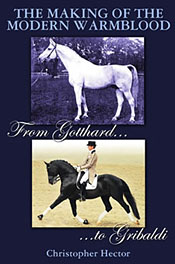 -- By Chris Hector
-- By Chris Hector
Chris Hector is the editor-in-chief of the Australian The Horse Magazine and author of the highly popular "From Gotthard to Gribaldi : The making of the modern warmblood." This 664 page hard cover Bible on Breeding is a treasure of information on the most important sport horse breeding stallions in modern history. Americans and Canadians can purchase the book (a perfect Christmas gift) through Shophorsesdaily.com, Europeans can order it via Media Book Service and every other breeding fan can obtain a copy via The Horse Magazine
Related Links
Guest Column: Keeping the Holsteiner Horse Up to Standard
Lauries Crusador xx, Hanoverian Stallion of the Year 2006
Lauries Crusador xx x Raphael Son, 2006 Hanoverian Licensing Champion